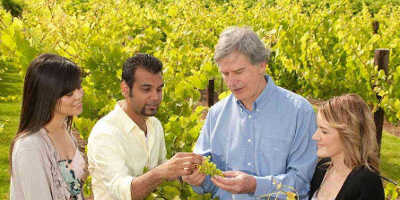How climate and soil change the taste of wine
Written by: Cameron Ward
Published: 02/06/2020
Reading time: 3 mins
When talking about wine regions or high-end wines, you’ll often see references to soil and climate. It is commonly believed that these two factors can have significant impact on a wine grapes flavour. So, lets examine some soils a little closer and see what we can come up with.
Soil
We’re going to begin with soil. Soil can change significantly between regions. In fact, soil regions can be quite small, the Barossa Valley alone has over 15 distinct soil types. Soils can typically be broken down into the following four categories.
-
Sandy Soils
Sandy soils are quite dry and are great at retaining heat; just think about how hot the sand is when you go to the beach! Typically, these soils grow grapes that are lighter in colour, and less acidic. These grapes are generally highly aromatic and are perfect for producing white wines such as cabernet sauvignon.
-
Clay Soils
Clay soils are quite the opposite of sandy soils. They are cool and likely to remain damp for long periods of time. Within this soil category there are plenty of sub-categories also. In fact, the Barossa Valley has many sub-categories of clay soil across it hills. Clay soil is particularly famous for producing bold, rich red wines; exactly what Barossa is famous for!
-
Silt Soils
Silt soils are particularly fine and loose. They hold heat and water well, and their properties change significantly depending on rainfall. Due to the fineness of this type of soil it can be incredibly hard to grow vines. Roots struggle to grow and weave through it. In order to combat this, many vineyards with silt soil will mix limestone through it. The diluted soil is easier to grow grapes in.
-
Loam Soils
The final soil type is Loam. Loam is an equal mix of sandy, clay and silt soil. However, this trio makes for a soil far too fertile to grow in. This means that loam is only used by vineyards that have diluted it by blending further soils into it.
Soil in the Barossa
Soil is thought to be so important to the wine that in 2008 the Barossa Grape & Wine Association established the Barossa Ground Project. The project involves collection and analysis of all soil types across the Barossa and nearby Eden Valley. There are over 15 soil types that have been documented and researched as part of the project!
Climate
Climate has one of the single biggest impacts on wine production. A simple rise or fall of temperature by just 1 degree can impact the flavour of a grape. Changes in climate can result in the following abnormalities in grapes, elevated sugar content, reduction in acidity, and loss of colour intensity. All these changes can result in significant changes in the final taste and composition of the wine.
Additionally, overall climate change is impacting the yield of wineries. Increasing temperatures can change the growth cycle of grapes, meaning that vineyards have to entirely reschedule their harvesting. Increased heat is also causing more pests to be attracted to vines. This will result in more resources needed in order to maintain wineries.
There are so many environmental factors that can impact the growth of wine grapes.
Related article: Penfolds Grange – the Barossa Valley’s most expensive wine




